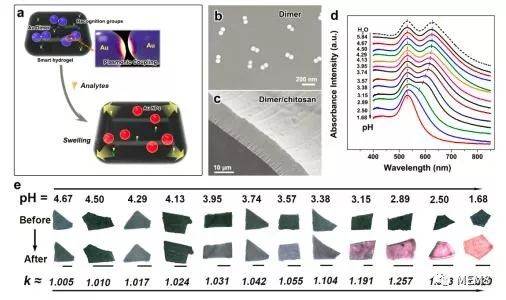Recently, a team led by Li Yue from the Micro-Nano Technology and Devices Research Institute at the Institute of Solid State Physics, Chinese Academy of Sciences, in collaboration with Deng Zhaoxiang, Li Liangbin from the University of Science and Technology of China, and Li Cuncheng from Jinan University, has made significant progress in the assembly of plasmon-coupled gold nanosphere dimers for colorimetric sensing. Their findings were recently published in Advanced Functional Materials.

This research introduces a novel colorimetric sensor device based on Au dimer/chitosan hydrogel systems. Colorimetric sensing is a technique that relies on changes in optical properties—such as absorption or emission—to detect analytes visually. It offers advantages such as portability, ease of use, and real-time monitoring, making it highly appealing for on-site detection applications.
In recent years, numerous colorimetric sensors based on noble metal nanoparticles have been developed for detecting heavy metals, food additives, and toxic substances. However, these sensors often suffer from issues like low sensitivity and instability due to the unpredictable aggregation or dispersion of the nanoparticles. The core components, which are typically precious metal nanoparticles, are prone to agglomeration and degradation, limiting their practical application.
To address these challenges, the research team successfully fabricated large-volume, high-quality gold nanosphere dimers using uniformly sized monodisperse gold nanospheres. They introduced a new strategy by integrating these dimers with smart hydrogels. By leveraging the high optical sensitivity and tunable gap-dependent properties of the Au dimers, they developed a highly sensitive and stable colorimetric sensor with a dynamically adjustable detection range.
The sensor works by exploiting the hydrogel’s ability to rapidly expand or contract in response to external stimuli. This allows precise control over the optical properties of the Au dimer, leading to enhanced sensitivity. Additionally, embedding the Au dimers within the hydrogel film prevents spontaneous aggregation and sedimentation, significantly improving the stability of the system.
The team also optimized the sensitivity by correlating the hydrogel’s expansion degree with its cross-linking density, thereby broadening the dynamic range of the sensor. This enables accurate detection across various concentration levels of target analytes. The study opens up new possibilities for controlling plasmonic coupling in gold nanosphere dimers and provides valuable insights for developing ultra-sensitive and stable sensor devices.
This research was supported by the National Key Research and Development Program, the National Natural Science Foundation, and the Anhui Natural Science Foundation.
Gas Explosion-Proof Motor,Explosion Proof Motors,Gas Explosion Proof Motors,Explosion Proof Electric Motor
Yizheng Beide Material Co., Ltd. , https://www.beidevendor.com